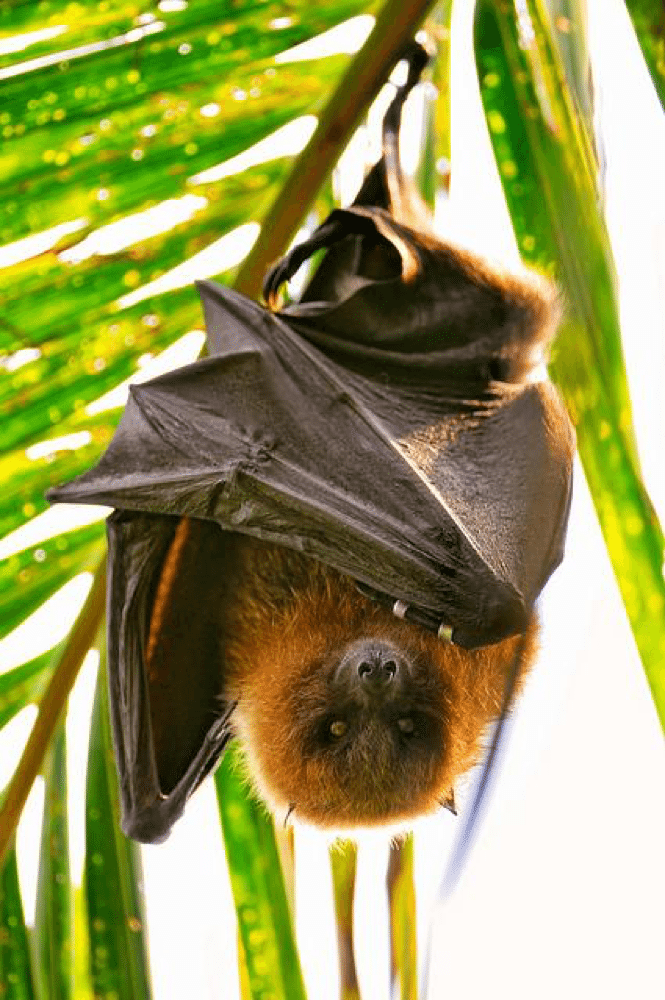A few months ago, we answered some common questions that people tend to have about wildlife behavior. Well, we had so much fun with that post that we’ve decided to do it again! Here are three more explanations for animal behavior and biology that often leave humans scratching their heads in confusion…or shaking their fists in annoyance:
“Are bats really blind?”

No. Though bats are famous for their ability to use echolocation in order to find prey and fly safely in total darkness, many of them will happily use their eyesight in conjunction with their natural radar to judge distances accurately or avoid obstacles. And if circumstances find them hunting or flying in bright light (which is uncommon for wild bats but sometimes observed in captive or “rescued” bats), they may more readily use their eyes than their echoes to navigate the world around them.
By animal standards, bats have relatively good vision. In fact, because some of them—namely, a few species of fruit bats—are capable of seeing certain colors of visible light and ultraviolet light, it could be argued that they actually have better vision than humans!
It’s a bit puzzling as to why so many people think that bats are blind. Maybe it’s due to the widespread knowledge that bats use echolocation; over time, the belief that bats don’t need to see in order to hunt and maneuver could have morphed into a belief that they can’t see at all. Or maybe a large number of people have stumbled upon confused, frightened bats bumping around inside man-made structures and assumed (incorrectly) that the creatures couldn’t escape because they couldn’t visually locate an exit. Regardless, the phrase “blind as a bat” should probably be retired. May we suggest “blind as a star-nosed mole” as a viable alternative? It’s a bit more of a mouthful, but at least it’s accurate.
“Why do cats act like they want a belly rub but then bite or scratch your hand when you try to give them one?”
Cats, like nearly all animals, have methods for conveying messages through body language; certain actions are their ways of communicating with fellow cats, humans, and even other animals. One such behavior is flopping over onto their back or side and exposing their belly. When a cat does this, they’re essentially saying, “I’m just going to kick back and relax here for a bit, because I trust that you’re not going to hurt me.” This gesture is largely symbolic, as the abdomen is the most vulnerable area of a cat’s body. By leaving it uncovered, they’re really putting a lot of faith in the human/animal/other cat to not attack this weak area.
Unfortunately, humans often misinterpret a cat flashing its belly as a request for petting or gentle scratching in this area, so they make a move to touch the cat’s abdomen. This action provokes the cat, who responds to the perceived boundary violation by biting or scratching. As the human is left bewildered by (and possibly angry at) the cat’s “fickle” behavior, the cat is thinking to itself, “What the heck?! I trusted you to not attack my belly, and you did it anyway!”
To be fair, some cats do actually enjoy belly scratches or snuggles from people they’re close to and trust completely—but it’s still not “normal” behavior for them. So, if you’re interacting with a friend’s cat (or a friendly cat you find wandering around outside), just stick to petting it on the head or back. Both you and the cat will likely have a much more positive experience that way.
“Will a hibernating mammal really sleep all winter long?”
Not exactly. Although a mammal may hibernate for months at a time during cold weather, this usually doesn’t mean that they’ll shut their eyes at the beginning of December and not open them again until March. Instead, the animal will sleep deeply for days or even weeks, wake up and be active for several hours, and then go back to sleep for another few days or weeks. During these hours of wakefulness, the animal will eat, relieve itself, and take care of any other important business before crashing once more. Hibernating allows certain creatures to survive a major slowdown in metabolism and a sharp drop in body temperature, but most of them can’t simply ignore all biological needs for an entire season.
It’s worth mentioning that, if an animal is trying to hibernate, humans should leave it alone unless relocating or interacting with it is truly necessary (e.g., a skunk has decided to make your backyard shed its “winter home”). Being awoken from dormancy is not only inconvenient and annoying for the critter in question, but it can have a negative effect on their health. After all, do you usually feel satisfied and well-rested when someone interrupts your REM sleep?
***
You don’t always have to understand an animal’s behavior or biology to find the animal fascinating, but it can certainly allow you to appreciate the wonders of nature on a different level. Chances are, if you think an animal “acts weird,” there’s actually a method to their madness.
In closing, we’d just like to remind folks that enjoying wild animals does not mean opening your home to them. House cats are really the only critters we just discussed who should not immediately be evicted if you notice them “setting up shop” on your property!






